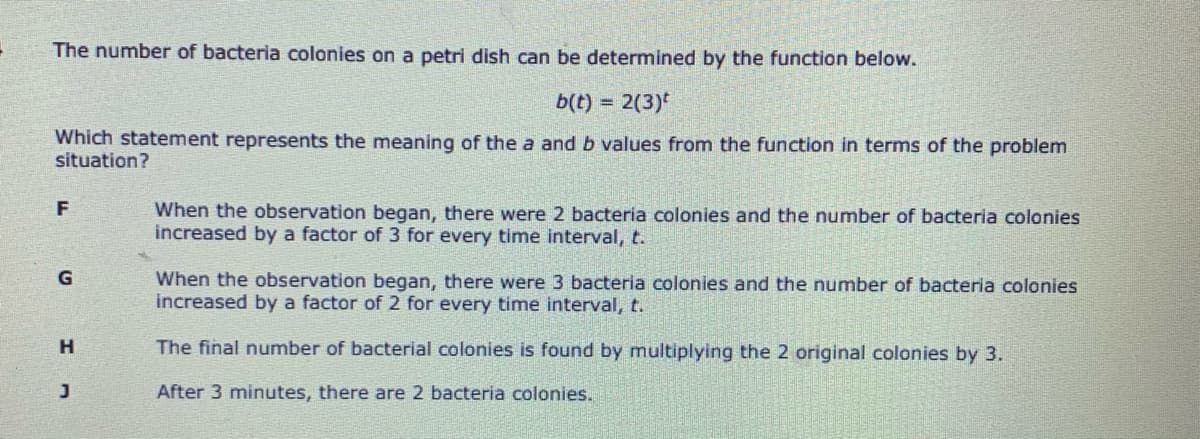The number of bacteria colonies on a petri dish can be determined by the function below. b(t) = 2(3) Which statement represents the meaning of the a and b values from the function in terms of the problem situation? F When the observation began, there were 2 bacteria colonies and the number of bacteria colonies increased by a factor of 3 for every time interval, t. G When the observation began, there were 3 bacteria colonies and the number of bacteria colonies increased by a factor of 2 for every time interval, t. The final number of bacterial colonies is found by multiplying the 2 original colonies by 3. After 3 minutes, there are 2 bacteria colonies.
The number of bacteria colonies on a petri dish can be determined by the function below. b(t) = 2(3) Which statement represents the meaning of the a and b values from the function in terms of the problem situation? F When the observation began, there were 2 bacteria colonies and the number of bacteria colonies increased by a factor of 3 for every time interval, t. G When the observation began, there were 3 bacteria colonies and the number of bacteria colonies increased by a factor of 2 for every time interval, t. The final number of bacterial colonies is found by multiplying the 2 original colonies by 3. After 3 minutes, there are 2 bacteria colonies.
Glencoe Algebra 1, Student Edition, 9780079039897, 0079039898, 2018
18th Edition
ISBN:9780079039897
Author:Carter
Publisher:Carter
Chapter3: Linear And Nonlinear Functions
Section3.2: Zeros Of Linear Fumctions
Problem 58PFA
Related questions
Question
100%

Transcribed Image Text:The number of bacteria colonies on a petri dish can be determined by the function below.
b(t) = 2(3)*
Which statement represents the meaning of the a and b values from the function in terms of the problem
situation?
F
When the observation began, there were 2 bacteria colonies and the number of bacteria colonies
increased by a factor of 3 for every time interval, t.
When the observation began, there were 3 bacteria colonies and the number of bacteria colonies
increased by a factor of 2 for every time interval, t.
H.
The final number of bacterial colonies is found by multiplying the 2 original colonies by 3.
After 3 minutes, there are 2 bacteria colonies.
Expert Solution
This question has been solved!
Explore an expertly crafted, step-by-step solution for a thorough understanding of key concepts.
This is a popular solution!
Trending now
This is a popular solution!
Step by step
Solved in 2 steps with 2 images

Knowledge Booster
Learn more about
Need a deep-dive on the concept behind this application? Look no further. Learn more about this topic, algebra and related others by exploring similar questions and additional content below.Recommended textbooks for you

Glencoe Algebra 1, Student Edition, 9780079039897…
Algebra
ISBN:
9780079039897
Author:
Carter
Publisher:
McGraw Hill


College Algebra
Algebra
ISBN:
9781305115545
Author:
James Stewart, Lothar Redlin, Saleem Watson
Publisher:
Cengage Learning

Glencoe Algebra 1, Student Edition, 9780079039897…
Algebra
ISBN:
9780079039897
Author:
Carter
Publisher:
McGraw Hill


College Algebra
Algebra
ISBN:
9781305115545
Author:
James Stewart, Lothar Redlin, Saleem Watson
Publisher:
Cengage Learning


Big Ideas Math A Bridge To Success Algebra 1: Stu…
Algebra
ISBN:
9781680331141
Author:
HOUGHTON MIFFLIN HARCOURT
Publisher:
Houghton Mifflin Harcourt

Algebra: Structure And Method, Book 1
Algebra
ISBN:
9780395977224
Author:
Richard G. Brown, Mary P. Dolciani, Robert H. Sorgenfrey, William L. Cole
Publisher:
McDougal Littell